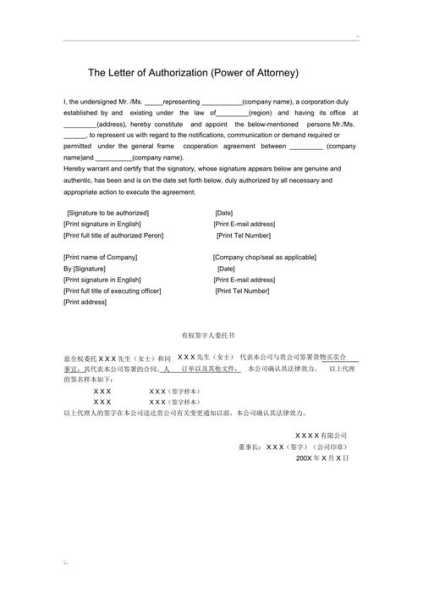This guide provides a comprehensive overview of the English format for a Personal Power of Attorney letter. It covers essential elements such as the letter's structure, key sections, and important considerations for drafting a legally binding document.
Introduction:

A personal power of attorney letter is a legally binding document that grants someone else the authority to act on your behalf in various matters. This document is crucial when you are unable to handle your own affairs due to illness, absence, or any other reason. In this article, we will discuss the English format of a personal power of attorney letter, ensuring that it is properly structured and legally enforceable.
I. Introduction
The introduction of a personal power of attorney letter should clearly state the purpose of the document. It should mention that you, as the principal, are granting the authority to another person, known as the attorney-in-fact or agent, to act on your behalf. Here is an example of an introduction:
[Your Name]
[Your Address]
[City, State, Zip Code]
[Email Address]
[Phone Number]
[Date]
To Whom It May Concern:
I, [Principal's Full Name], hereby appoint [Agent's Full Name] as my attorney-in-fact, granting them the authority to act on my behalf in the following matters:
[Specify the scope of authority]
This power of attorney is effective from [Start Date] and will remain in effect until [End Date] or until revoked by me in writing.
II. Body
The body of the personal power of attorney letter should detail the following information:
A. Full Names and Identifying Information
Ensure that the full names of both the principal and the agent are clearly stated. Additionally, provide any other identifying information, such as addresses, phone numbers, and email addresses.
B. Scope of Authority
Specify the scope of authority granted to the agent. This can include financial matters, real estate transactions, healthcare decisions, and other personal matters. Be as specific as possible to avoid any ambiguity.
C. Duties and Responsibilities
State the duties and responsibilities of the agent. This may include the agent's obligation to act in the best interests of the principal, maintain accurate records, and communicate with the principal when necessary.
D. Compensation
If the agent is to be compensated for their services, clearly state the compensation terms. This can be a fixed amount, a percentage of the transactions handled, or other agreed-upon terms.
E. Termination Clause
Include a clause that outlines the conditions under which the power of attorney may be terminated. This can include the agent's resignation, the principal's death, or the expiration of the specified term.
III. Acknowledgment and Signatures
The personal power of attorney letter should be signed by both the principal and the agent in the presence of a witness or notary public. Here is an example of the acknowledgment and signature section:
In Witness Whereof, I, [Principal's Full Name], have executed this Power of Attorney Letter as of the date first above written.
Principal's Signature:
_________________________
[Principal's Full Name]
Agent's Signature:
_________________________
[Agent's Full Name]
Witness's Signature:
_________________________
[Witness's Full Name]
Notary Public:
_________________________
[Notary Public's Full Name]
[Notary Public's Title]
[Notary Public's Seal]
IV. Legal Considerations
It is important to note that the format of a personal power of attorney letter may vary depending on the jurisdiction. Here are some legal considerations to keep in mind:
A. Jurisdiction-Specific Requirements
Ensure that the personal power of attorney letter complies with the laws and regulations of the state or country where it will be used. This may include specific language, formatting requirements, or the need for a notary public.
B. Witness or Notary Public
In some jurisdictions, a witness or notary public must be present during the signing of the document. Check the laws in your jurisdiction to determine if this is necessary.
C. Durable vs. Non-Durable Power of Attorney
A durable power of attorney remains in effect even if the principal becomes incapacitated, while a non-durable power of attorney terminates upon the principal's incapacity. Choose the appropriate type based on your needs.
V. Conclusion
A well-structured personal power of attorney letter is essential for ensuring that your affairs are handled properly when you are unable to do so. By following the English format outlined in this article and considering the legal requirements of your jurisdiction, you can create a legally enforceable document that grants the necessary authority to your agent.
Remember to consult with a legal professional if you have any doubts about the content or legal validity of your personal power of attorney letter. With proper planning and execution, you can have peace of mind knowing that your interests will be protected when you need it most.
Note: The above article is for informational purposes only and does not constitute legal advice. It is essential to consult with a qualified attorney when drafting a personal power of attorney letter to ensure compliance with local laws and regulations.
相关阅读:
1、Effective Techniques and Key Points for Drafting English-Chinese Power of Attorney Translations
2、Essential Guide to Writing a Comprehensive Personal English Power of Attorney
3、Ultimate Guide to Drafting Power of Attorney Documents: English Format Sample Explanation
4、Ultimate English Template Guide to Crafting a Personal Power of Attorney
5、Mastering the English Format: A Step-by-Step Guide to Power of Attorney Deeds











